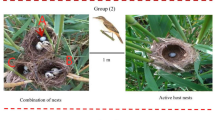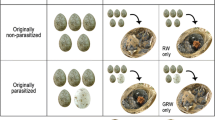Abstract
Obligate brood parasitic birds, such as cowbirds, evade parental care duties by laying their eggs in the nests of other species. Cowbirds are assumed to avoid laying repeatedly in the same nest so as to prevent intrabrood competition between their offspring. However, because searching for host nests requires time and energy, laying more than one egg per nest might be favoured where hosts are large and can readily rear multiple parasites per brood. Such ‘repeat parasitism’ by females would have important consequences for parasite evolution because young parasites would then incur indirect fitness costs from behaving selfishly. We investigated shiny cowbird (Molothrus bonariensis) parasitism of a large host, the chalk-browed mockingbird (Mimus saturninus), in a population where over 70 % of the parasitized mockingbird nests receive multiple cowbird eggs. We assessed egg maternity directly, using cameras at nests to film the laying of individually-marked females. We also supplemented video data with evidence from egg morphology, after confirming that each female lays eggs of a consistent appearance. From 133 eggs laid, we found that less than 5 % were followed by the same female visiting the nest to lay again or to puncture eggs. Multiple eggs in mockingbird nests were instead the result of different females, with up to eight individuals parasitizing a single brood. Thus, while cowbird chicks regularly share mockingbird nests with conspecifics, these are unlikely to be their maternal siblings. Our results are consistent with shiny cowbird females following a one-egg-per-nest rule, even where hosts can rear multiple parasitic young.





Similar content being viewed by others
References
Alderson GW, Gibbs HL, Sealy SG (1999) Determining the reproductive behaviour of individual brown-headed cowbirds using microsatellite DNA markers. Anim Behav 58:895–905
Briskie JV, Naugler CT, Leech SM (1994) Begging intensity of nestling birds varies with sibling relatedness. Proc R Soc Lond B 258:73–78
Davies NB (2000) Cuckoos, cowbirds and other cheats. Princeton University Press, London
Davies NB, Brooke MDL (1988) Cuckoos versus reed warblers: adaptations and counteradaptations. Anim Behav 36:262–284
De la Colina MA, Mahler B, Reboreda JC (2011) Differences in morphology and color pattern of shiny cowbird (Molothrus bonariensis) eggs found in nests of two hosts. Biol J Linn Soc 102:838–845
Dearborn DC, Lichtenstein G (2002) Begging behaviour and host exploitation in parasitic cowbirds. In: Wright J, Leonard ML (eds) The evolution of begging: competition, cooperation and communication. Kulwer Academic Publishers, Dordrecht, pp 361–388
Dufty AM (1983) Variation in the egg markings of the brown-headed cowbird. Condor 85:109–111
Ellison K, Sealy SG, Gibbs HL (2006) Genetic elucidation of host use by individual sympatric bronzed cowbirds (Molothrus aeneus) and brown-headed cowbirds (M. ater). Can J Zool 84:1269–1280
Fiorini VD, Tuero DT, Reboreda JC (2009a) Host behaviour and nest-site characteristics affect the likelihood of brood parasitism by shiny cowbirds in chalk-browed mockingbirds. Behaviour 146:1387–1403
Fiorini VD, Tuero DT, Reboreda JC (2009b) Shiny cowbirds synchronize parasitism with host laying and puncture host eggs according to host characteristics. Anim Behav 77:561–568
Fraga RM (1985) Host-parasite interactions between chalk-browed mockingbirds and shiny cowbirds. Ornithol Monogr 36:829–844
Friedmann H, Kiff LF (1985) The parasitic cowbirds and their hosts. Proc West Found Vert Zool 2:225–302
Gloag R, Tuero DT, Fiorini VD, Reboreda JC, Kacelnik A (2012a) The economics of nestmate killing in avian brood parasites: a provisions trade-off. Behav Ecol 23:132–140
Gloag R, Fiorini VD, Reboreda JC, Kacelnik A (2012b) Brood parasite eggs enhance egg survivorship in a multiply parasitized host. Proc R Soc Lond B 279:1831–1839
Gloag R, Fiorini VD, Reboreda JC, Kacelnik A (2013) The wages of violence: mobbing by mockingbirds as a frontline defence against brood parasitic cowbirds. Anim Behav 86:1023–1029
Godfray HCJ (1995) Signaling of need between parents and young: parent–offspring conflict and sibling rivalry. Am Nat 146:1–24
Goguen CB, Curson DR, Mathews NE (2011) Costs of multiple parasitism for an avian brood parasite, the brown-headed cowbird (Molothrus ater). Can J Zool 89:1237–1248
Hahn DC, Sedgwick JA, Painter IS, Casna NJ (1999) A spatial and genetic analysis of cowbird host selection. Stud Avian Biol 18:204–217
Hauber ME, Ramsey CK (2003) Honesty in host-parasite communication signals: the case for begging by fledgling brown-headed cowbirds Molothrus ater. J Avian Biol 34:339–344
Hauber ME, Yeh PJ, Roberts JO (2004) Patterns and coevolutionary consequences of repeated brood parasitism. Proc R Soc Lond B 271(S5):S317–S320
Hoover JP (2003) Multiple effects of brood parasitism reduce the reproductive success of prothonotary warblers, Protonotaria citrea. Anim Behav 65:923–934
Hoover JP, Yasukawa K, Hauber ME (2006) Spatially and temporally structured avian brood parasitism affects the fitness benefits of hosts’ rejection strategies. Anim Behav 72:881–890
Hudson WH (1874) Notes on the procreant instincts of the three species of Molothrus found in Buenos Aires. Proc Zool Soc London 11:153–174
Kattan GH (1997) Shiny cowbirds follow the ‘shotgun’ strategy of brood parasitism. Anim Behav 53:647–654
Kilner R (2005) The evolution of virulence in brood parasites. Ornithol Sci 4:55–64
Kilner RM, Madden JR, Hauber ME (2004) Brood parasitic cowbird nestlings use host young to procure resources. Science 305:877–879
Langmore NE, Kilner RM (2007) Breeding site and host selection by Horsfield’s bronze-cuckoos, Chalcites basalis. Anim Behav 74:995–1004
Langmore NE, Adcock GJ, Kilner RM (2007) The spatial organization and mating system of Horsfield’s bronze-cuckoos, Chalcites basalis. Anim Behav 74:403–412
Lichtenstein G, Dearborn DC (2004) Begging and short-term need in cowbird nestlings: how different are brood parasites. Behav Ecol Sociobiol 56:352–359
Lyon BE (1997) Spatial patterns of shiny cowbird brood parasitism on chestnut-capped blackbirds. Anim Behav 54:927–939
Mahler B, Confalonieri VA, Lovette IJ, Reboreda JC (2007) Partial host fidelity in nest selection by the shiny cowbird (Molothrus bonariensis), a highly generalist avian brood parasite. J Evol Biol 20:1918–1923
Mason P (1986) Brood parasitism in a host generalist the shiny cowbird: I. The quality of different species as hosts. Auk 103:52–60
McLaren CM, Sealy SG, Woolfenden BE, Gibbs HL (2003) Genetic and temporal patterns of multiple parasitism by brown-headed cowbirds (Molothrus ater) on song sparrows (Melospiza melodia). Can J Zool 81:281–286
Mermoz ME, Ornelas JF (2004) Phylogenetic analysis of life-history adaptations in parasitic cowbirds. Behav Ecol 15:109–119
Mermoz ME, Reboreda JC (1994) Brood parasitism of the shiny cowbird, Molothrus bonariensis, on the brown-and-yellow marshbird, Pseudoleistes virescens. Condor 96:716–721
Moksnes A, Røskaft E, Rudolfsen G, Skjelseth S, Stokke B, Kleven O, Gibbs H, Honza M, Taborsky B, Teuschl Y, Vogl W, Taborsky M (2008) Individual female common cuckoos Cuculus canorus lay constant egg types but egg appearance cannot be used to assign eggs to females. J Avian Biol 39:238–241
Moskat C, Barta Z, Hauber ME, Honza M (2006) High synchrony of egg laying in common cuckoos (Cuculus canorus) and their great reed warbler (Acrocephalus arundinaceus) hosts. Ethol Ecol Evol 18:159–167
Ortega CP (1998) Cowbirds and other parasites. The University of Arizona Press, Tucson, pp 215–217
Payne LL (1977) Clutch size, egg size and the consequences of single versus multiple parasitism in parasitic finches. Ecology 58:500–513
Polačiková L, Procházka P, Cherry MI, Honza M (2008) Choosing suitable hosts: common cuckoos Cuculus canorus parasitize great reed warblers Acrocephalus arundinaceus of high quality. Evol Ecol 23:879–891
Post W, Wiley JW (1977) Reproductive interactions of the shiny cowbird and the yellow-shouldered blackbird. Condor 79:176–184
Rivers JW, Althoff DP, Gipson PS, Pontius JS (2003) Evaluation of a reproductive index to estimate dickcissel reproductive success. J Wildlife Manage 67:136–143
Rivers JW, Young S, Gonzalez EG, Horton B, Lock J, Fleischer RC (2012) High levels of relatedness between brown-headed cowbird (Molothrus ater) nestmates in a heavily parasitized host community. Auk 129:623–631
Sackmann P, Reboreda JC (2003) A comparative study of shiny cowbird parasitism of two large hosts, the chalk-browed mockingbird and the rufous-bellied thrush. Condor 105:728–736
Salvador SA (1984) Study of parasitism in raising shiny cowbirds Molothrus bonariensis and chalk-browed mockingbirds Mimus saturninus in Villa Maria Cordoba Argentina. Hornero 12:141–149
Segura LN, Reboreda JC (2012) Red-crested cardinal defenses against shiny cowbird parasitism. Behaviour 149:325–343
Soler M, Pérez-Contreras T (2012) Location of suitable nests by great spotted cuckoos: an empirical and experimental study. Behav Ecol Sociobiol 66:1305–1310
Soler JJ, Soler M, Møller AP, Martinez JG (1995) Does the great spotted cuckoo choose magpie hosts according to their parenting ability? Behav Ecol Sociobiol 36:201–206
Spottiswoode CN, Stevens M (2011) How to evade a coevolving brood parasite: egg discrimination versus egg variability as host defences. Proc R Soc Lond B 278:3566–3573
Strausberger BM, Ashley MV (2003) Breeding biology of brood parasitic brown-headed cowbirds (Molothrus ater) characterized by parent-offspring and sibling-group reconstruction. Auk 120:433–445
Teuschl Y, Taborsky B, Taborsky M (1998) How do cuckoos find their hosts? The role of habitat imprinting. Anim Behav 56:1425–1433
Trine CL (2000) Effects of multiple parasitism on cowbird and wood thrush nesting success. In: Smith JNM, Cook TL, Rothstein SI, Robinson GE, Sealy SG (eds) Ecology and management of cowbirds and their hosts. University of Texas Press, Austin, pp 135–155
Tuero DT, Fiorini VD, Reboreda JC (2007) Effects of Shiny Cowbird Molothrus bonariensis parasitism on different components of House Wren Troglodytes aedon reproductive success. Ibis 149:521–529
Zar JH (1999) Biostatistical Analysis. 4th Edition. Prentice-Hall International Ltd., London pp. 527–528
Acknowledgments
We thank our anonymous reviewers for their helpful comments on this manuscript. We thank Juan Shaw and the Elsa Shaw de Pearson Foundation for supporting our fieldwork at Reserva El Destino. We also thank Romina Scardamaglia, María Cecilia De Mársico and Cynthia Ursino, for helping to trap birds in the field, and the five volunteers that performed the scoring of eggs. We are grateful to Agencia Nacional de Promoción Científica y Tecnológica (Proyecto PICT Raíces 2011-0045) and the Cogito Foundation for funding. RG was supported by the Cogito Foundation. JCR and VDF are Research Fellows of Consejo Nacional de Investigaciones Científicas y Técnicas (CONICET).
Ethical standards
This research was conducted in accordance with relevant Argentinean regulations (Law of Conservation of Wild Fauna), under the permit issued to JCR, University of Buenos Aires.
Author information
Authors and Affiliations
Corresponding author
Additional information
Communicated by M. Soler
Electronic supplementary material
Below is the link to the electronic supplementary material.
An example of the recording of a multiply parasitized mockingbird nest, showing how nest cams and individually marked females were used to determine the maternity of cowbird eggs in the same nest (MPG 62312 kb)
Rights and permissions
About this article
Cite this article
Gloag, R., Fiorini, V.D., Reboreda, J.C. et al. Shiny cowbirds share foster mothers but not true mothers in multiply parasitized mockingbird nests. Behav Ecol Sociobiol 68, 681–689 (2014). https://doi.org/10.1007/s00265-014-1682-2
Received:
Revised:
Accepted:
Published:
Issue Date:
DOI: https://doi.org/10.1007/s00265-014-1682-2




